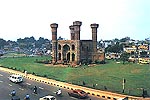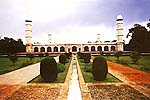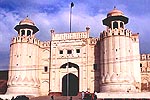Lahore is the second largest city of Pakistan and the provincial
capital of Punjab. Apart from being the cultural and academic centre
of the country, Lahore is the Mughal "show-window" of Pakistan.
 In the Mughal days a 9-meter high brick wall surrounded the Old City. It had a rampart running around
it which almost connected with the River Ravi to serve as protection
for the city. A circular road around the rampart gave access to the
city through thirteen gates. Some of the imposing structures of
these gates are still preserved. In the bazaars of the Old City one
can still find tiny shops where craftsmen can be seen busy turning
out master-pieces in copper, brass, silver and textiles in
traditional fashion.
In the Mughal days a 9-meter high brick wall surrounded the Old City. It had a rampart running around
it which almost connected with the River Ravi to serve as protection
for the city. A circular road around the rampart gave access to the
city through thirteen gates. Some of the imposing structures of
these gates are still preserved. In the bazaars of the Old City one
can still find tiny shops where craftsmen can be seen busy turning
out master-pieces in copper, brass, silver and textiles in
traditional fashion.
In modern days, Lahore hosts a large number of industrial units running day and night to play their vital role in developing the country's economy. Lahore is also an important center of journalistic activities. A large number of newspapers, journals and magazines are published here. Lahore is a great commercial and trade center. It has combined the life style of east and west and presents a lively mixture of some old and new patterns of life.
The most important historical monuments of the Moghul's in Lahore
are; the Royal Fort (Shahi Qila), the Badshahi Mosque. The
Independance monument, the tombs of emperor Jehangir,
 Noor Jehan, Anarkali, Asif-Jah and the famous Shalimar Gardens. In the old part of the town and off
the Kashmir Bazaar, reputedly the most beautiful Mosque of South
Asia is located, the "Wazir Khan's Mosque'. It is a marvellous
specimen of tile work and arabesque paintings. The Imperial or the
Badshahi Mosque is accross the courtyard from Alamgiri Gate of the
Lahore Fort. The Mosque, made up entirely of red sandstone, was
built by Emperor Aurangzeb. 5 kms east of old city, are the famous
Shalimar Gardens laid out by Mughal Emperor Shah-Jehan in 1642 A.D.
The Gardens are set out in typical Mughul style and are surrounded
by high walls with watchtowers at the four corners. The Golden
Mosque is also situated in the Kashmiri Bazaar. It was built in 1753
A.D. by Nawab Syed Bhikari Khan who was Deputy Governor of Lahore.
Noor Jehan, Anarkali, Asif-Jah and the famous Shalimar Gardens. In the old part of the town and off
the Kashmir Bazaar, reputedly the most beautiful Mosque of South
Asia is located, the "Wazir Khan's Mosque'. It is a marvellous
specimen of tile work and arabesque paintings. The Imperial or the
Badshahi Mosque is accross the courtyard from Alamgiri Gate of the
Lahore Fort. The Mosque, made up entirely of red sandstone, was
built by Emperor Aurangzeb. 5 kms east of old city, are the famous
Shalimar Gardens laid out by Mughal Emperor Shah-Jehan in 1642 A.D.
The Gardens are set out in typical Mughul style and are surrounded
by high walls with watchtowers at the four corners. The Golden
Mosque is also situated in the Kashmiri Bazaar. It was built in 1753
A.D. by Nawab Syed Bhikari Khan who was Deputy Governor of Lahore.
The ashes of the Sikh ruler of Punjab, Maharaja Ranjeet Singh, and of
his four wives lie in a dome adjacent to the Hazoori Bagh and is
famously known as 'Samadhy of Maharaja Ranjeet Singh'.
 Apart from these there are certain Shrines and Mausoleums like the Shrine of Data Sahib (Hazrat
Ali Hajveri), the Mausoleum of Emperor Jehangir, Asif Khan's
(Jehangir's brother-in-law) Mausoleum, Empress Noor Jehan's (light
of the world) Tomb whose name appeared on the coins of the Mughal
Empire, Qutbuddin Aibak's Tomb, Anarkali's Tomb and the tomb of
Allama Muhammad Iqbal who has been hailed as the poet-philosopher of
the East.
Apart from these there are certain Shrines and Mausoleums like the Shrine of Data Sahib (Hazrat
Ali Hajveri), the Mausoleum of Emperor Jehangir, Asif Khan's
(Jehangir's brother-in-law) Mausoleum, Empress Noor Jehan's (light
of the world) Tomb whose name appeared on the coins of the Mughal
Empire, Qutbuddin Aibak's Tomb, Anarkali's Tomb and the tomb of
Allama Muhammad Iqbal who has been hailed as the poet-philosopher of
the East.
Lahore is a city full of life and color. It has something for everyone. Large number of beautiful gardens, historically exotic forts, mosques and shrines, mughal architectures and museums, shopping centres, fairs and festivals all add-up to make Lahore as Pakistan's most surprisingly colorful package!


